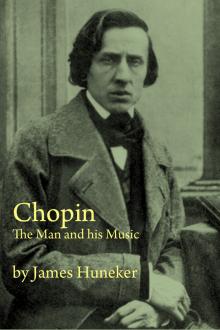Chopin: The Man and His Music, James Huneker [free e books to read online txt] 📗

- Author: James Huneker
- Performer: -
Book online «Chopin: The Man and His Music, James Huneker [free e books to read online txt] 📗». Author James Huneker
But as Rossini would have said, “Ca sent de Scarlatti!”
The A minor Valse was, of the three, Chopin’s favorite. When Stephen Heller told him this too was his beloved valse, Chopin was greatly pleased, inviting the Hungarian composer, Niecks relates, to luncheon at the Cafe Riche.
Not improvised in the ballroom as the preceding, yet a marvellous epitome is the A flat Valse, op. 42, published July, 1840. It is the best rounded specimen of Chopin’s experimenting with the form. The prolonged trill on E flat, summoning us to the ballroom, the suggestive intermingling of rhythms, duple and triple, the coquetry, hesitation, passionate avowal and the superb coda, with its echoes of evening—have not these episodes a charm beyond compare? Only Schumann in certain pages of his “Carneval” seizes the secret of young life and love, but his is not so finished, so glowing a tableau.
Regarding certain phrasing of this valse Moriz Rosenthal wrote to the London “Musical Standard”:
In Music there is Liberty and Fraternity, but seldom Equality, and in music Social Democracy has no voice. Notes have a right to the Aftertone (Nachton), and this right depends upon their role in the key. The Vorhalt (accented passing note) will always have an accent. On this point Riemann must without question be considered right. Likewise the feeling player will mark those notes that introduce the transition to another key.
We will consider now our example and set down my accents: [Musical score excerpt]
In the first bar we have the tonic chord of its major key as bass, and are thus not forced to any accent. In the second bar we have the dominant harmony in the bass, and in the treble, C, which falls upon the down beat as Vorhalt to the next tone (B flat), so it must be accented. Also in the fourth bar the B
flat is Vorhalt to the B flat, and likewise requires an accent. In bars 6, 7 and 8 the notes, A flat, B flat and C, are without doubt the characteristic ones of the passage, and the E flat has in each case only a secondary significance.
That a genius like Chopin did not indicate everything accurately is quite explainable. He flew where we merely limp after. Moreover, these accents must be felt rather than executed, with softest touch, and as tenderly as possible.
The D flat Valse—“le valse du petit chien”—is of George Sand’s own prompting. One evening at her home in the Square d’Orleans, she was amused by her little pet dog, chasing its tail. She begged Chopin, her little pet pianist, to set the tail to music. He did so, and behold the world is richer for this piece. I do not dispute the story. It seems well grounded, but then it is so ineffably silly! The three valses of this op. 64 were published September, 1847, and are respectively dedicated to the Comtesse Delphine Potocka, the Baronne Nathaniel de Rothschild and the Baronne Bronicka.
I shall not presume to speak of the execution of the D flat Valse; like the rich, it is always with us. It is usually taken at a meaningless, rapid gait. I have heard it played by a genuine Chopin pupil, M.
Georges Mathias, and he did not take it prestissimo. He ran up the D
flat scale, ending with a sforzato at the top, and gave a variety of nuance to the composition. The cantabile is nearly always delivered with sloppiness of sentiment. This valse has been served up in a highly indigestible condition for concert purposes by Tausig, Joseffy—whose arrangement was the first to be heard here—Theodore Ritter, Rosenthal and Isidor Philipp.
The C sharp minor Valse is the most poetic of all. The first theme has never been excelled by Chopin for a species of veiled melancholy. It is a fascinating, lyrical sorrow, and what Kullak calls the psychologic motivation of the first theme in the curving figure of the second does not relax the spell. A space of clearer skies, warmer, more consoling winds are in the D flat interlude, but the spirit of unrest, ennui returns. The elegiac imprint is unmistakable in this soul dance. The A flat Valse which follows is charming. It is for superior souls who dance with intellectual joy, with the joy that comes of making exquisite patterns and curves. Out of the salon and from its brilliantly lighted spaces the dancers do not wander, do not dance into the darkness and churchyard, as Ehlert imagines of certain other valses.
The two valses in op. 69, three valses, op. 70, and the two remaining valses in E minor and E major, need not detain us. They are posthumous.
The first of op. 69 in F minor was composed in 1836; the B minor in 1829; G flat, op. 70, in 1835; F minor in 1843, and D flat major, 1830.
The E major and E minor were composed in 1829. Fontana gave these compositions to the world. The F minor Valse, op. 69, No. 1, has a charm of its own. Kullak prints the Fontana and Klindworth variants.
This valse is suavely melancholy, but not so melancholy as the B minor of the same opus. It recalls in color the B minor mazurka. Very gay and sprightly is the G flat Valse, op. 70, No. I. The next in F minor has no special physiognomy, while the third in D flat contains, as Niecks points out, germs of the op. 42 and the op. 34 Valses. It recalls to me the D flat study in the supplementary series. The E minor Valse, without opus, is beloved. It is very graceful and not without sentiment. The major part is the early Chopin. The E major Valse is published in the Mikuli edition. It is commonplace, hinting of its composer only in places. Thus ends the collection of valses, not Chopin’s most signal success in art, but a success that has dignified and given beauty to this conventional dance form.
IX. NIGHT AND ITS MELANCHOLY MYSTERIES:—THE NOCTURNES
Here is the chronology of the nocturnes: Op. 9, three nocturnes, January, 1833; op. 15, three nocturnes, January, 1834; op. 27, two nocturnes, May, 1836; op. 32, two nocturnes, December, 1837; op. 37, two nocturnes, May, 1840; op. 48, two nocturnes, November, 1841; op.
55, two nocturnes, August, 1844; op. 62, two nocturnes, September, 1846. In addition there is a nocturne written in 1828 and published by Fontana, with the opus number 72, No. 2, and the lately discovered one in C sharp minor, written when Chopin was young and published in 1895.
This completes the nocturne list, but following Niecks’ system of formal grouping I include the Berceuse and Barcarolle as full fledged specimens of nocturnes.
John Field has been described as the forerunner of Chopin. The limpid style of this pupil and friend of Clementi, his beautiful touch and finished execution, were certainly admired and imitated by the Pole.
Field’s nocturnes are now neglected—so curious are Time’s caprices—and without warrant, for not only is Field the creator of the form, but in both his concertos and nocturnes he has written charming, sweet and sane music. He rather patronized Chopin, for whose melancholy pose he had no patience. “He has a talent of the hospital,” growled Field in the intervals between his wine drinking, pipe smoking and the washing of his linen—the latter economical habit he contracted from Clementi. There is some truth in his stricture. Chopin, seldom exuberantly cheerful, is morbidly sad and complaining in many of the nocturnes. The most admired of his compositions, with the exception of the valses, they are in several instances his weakest. Yet he ennobled the form originated by Field, giving it dramatic breadth, passion and even grandeur. Set against Field’s naive and idyllic specimens, Chopin’s efforts are often too bejewelled for true simplicity, too lugubrious, too tropical—Asiatic is a better word—and they have the exotic savor of the heated conservatory, and not the fresh scent of the flowers reared in the open by the less poetic Irishman. And, then, Chopin is so desperately sentimental in some of these compositions.
They are not altogether to the taste of this generation; they seem to be suffering from anaemia. However, there are a few noble nocturnes; and methods of performance may have much to answer for the sentimentalizing of some others. More vigor, a quickening of the time-pulse, and a less languishing touch will rescue them from lush sentiment. Chopin loved the night and its soft mysteries as much as did Robert Louis Stevenson, and his nocturnes are true night pieces, some with agitated, remorseful countenance, others seen in profile only, while many are whisperings at dusk. Most of them are called feminine, a term psychologically false. The poetic side of men of genius is feminine, and in Chopin the feminine note was over emphasized—at times it was almost hysterical—particularly in these nocturnes.
The Scotch have a proverb: “She wove her shroud, and wore it in her lifetime.” In the nocturnes the shroud is not far away. Chopin wove his to the day of his death, and he wore it sometimes but not always, as many think.
One of the most elegiac of his nocturnes is the first in B flat minor.
It is one of three, op. 9, dedicated to Mme. Camille Pleyel. Of far more significance than its two companions, it is, for some reason, neglected. While I am far from agreeing with those who hold that in the early Chopin all his genius was completely revealed, yet this nocturne is as striking as the last, for it is at once sensuous and dramatic, melancholy and lovely. Emphatically a mood, it is best heard on a gray day of the soul, when the times are out of joint; its silken tones will bring a triste content as they pour out upon one’s hearing. The second section in octaves is of exceeding charm. As a melody it has all the lurking voluptuousness and mystic crooning of its composer. There is flux and reflux throughout, passion peeping out in the coda.
The E flat nocturne is graceful, shallow of content, but if it is played with purity of touch and freedom from sentimentality it is not nearly so banal as it usually seems. It is Field-like, therefore play it as did Rubinstein, in a Field-like fashion.
Hadow calls attention to the “remote and recondite modulations” in the twelfth bar, the chromatic double notes. For him they only are one real modulation, “the rest of the passage is an iridescent play of color, an effect of superficies, not an effect of substance.” It was the E flat nocturne that unloosed Rellstab’s critical wrath in the “Iris.” Of it he wrote: “Where Field smiles, Chopin makes a grinning grimace; where Field sighs, Chopin groans; where Field shrugs his shoulders, Chopin twists his whole body; where Field puts some seasoning into the food, Chopin empties a handful of cayenne pepper. In short, if one holds Field’s charming romances before a distorting, concave mirror, so that every delicate impression becomes a coarse one, one gets Chopin’s work.
We implore Mr. Chopin to return to nature.”
Rellstab might have added that while Field was often commonplace, Chopin never was. Rather is to be preferred the sound judgment of J. W.
Davison, the English critic and husband of the pianist, Arabella Goddard. Of the early works he wrote:
Commonplace is instinctively avoided in all the works of Chopin—a stale cadence or a trite progression—a hum-drum subject or a worn-out passage—a vulgar twist of the melody





Comments (0)